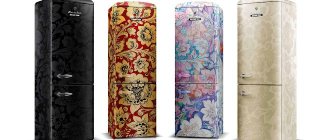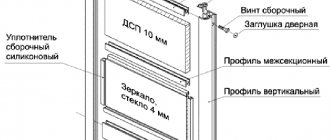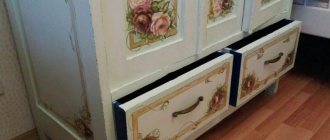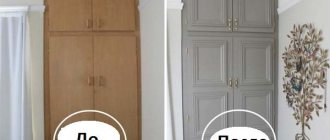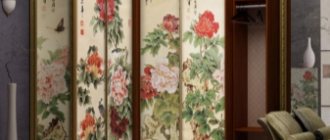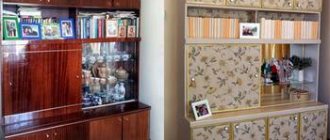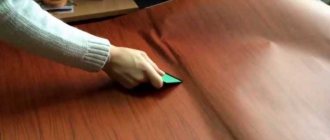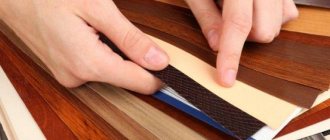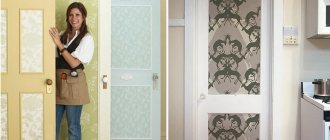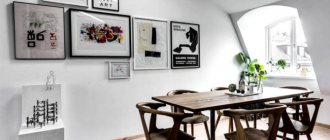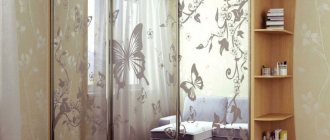Interior items, even the highest quality ones, lose their attractiveness over time. In the bustle of gray everyday life, people stop paying attention to them, and when it comes to updating the design, they try to replace old things with new ones. However, the budget does not always allow you to update the design, give walls, furniture, doors, and window sills a fresh look. In such situations, decoration is used, and questions related to how to cover a cabinet with self-adhesive film, how to decorate shelves, mirrors, glass, and other elements become relevant.
- Required tools and materials
Peculiarities
Self-adhesive film used for pasting furniture elements is a special material made from polyester, polyvinyl chloride, and propylene. On one side it has a decorative design in the form of a pattern, color, texture, on the other it is covered with an adhesive layer protected by paper, which is removed before gluing. The products are available in rolls, like regular wallpaper, but no glue is required for their application.
There are two main manufacturing technologies: calendering and casting. In the first case, the film is produced by rolling a plastic mixture through a series of heated rollers. In the second option, colorless, transparent plastic is dissolved in solvents and poured onto a special substrate. After several additional production cycles, the resulting raw material is quite thin.
Depending on the production method, single-layer and two-layer fabric structures are distinguished. Depending on the type of surface, there are glossy, matte, mirror, transparent, and holographic options. The products are used in different rooms, even in the bathroom. They can be glued to the work area in the kitchen, furniture, refrigerator, windows, doors. You can also use special stickers made of the same material for decoration.
Canvases can perform a protective and decorative function. They are able to protect the surface from the negative effects of moisture, prevent scratches and chips.
Make a slate surface
Chalkboards are all the rage right now, so why not make one out of cabinet doors? The slate effect can be easily achieved in two ways: buy a film or paint the chest of drawers with chalkboard effect paint.
Advantages and disadvantages
The film allows you to completely renew the facades of furniture, and no special skills are required to work with it. Thanks to a huge selection of textures, colors, images, you can choose the right canvas for any interior of a bedroom, living room, hallway, nursery, office. The material has gained great popularity due to its advantages, among which are:
- Low cost. Decorating will cost several times less than purchasing new things.
- Interior renovation. With the help of the material you can often change the design of any room.
- Easy installation and dismantling. Anyone can carry out the work of applying and removing the canvas, without any additional tools.
- Easy cleaning. The surface can be cleaned using a regular sponge and water.
- Manifold. A large number of shades and textures makes the catalog products universal; they fit into any interior.
- Moisture resistance. The canvas does not allow water to pass through, it can even be used in the kitchen and bathroom, but it cannot withstand prolonged wetness.
- Resistance to household chemicals. For cleaning, you can use regular detergents.
- Resistant to temperature changes. The film is not afraid of either cold or heat, even sudden temperature changes.
Like any other material, self-adhesive products are not without disadvantages:
- Fragility. The service life of even the highest quality models does not exceed five years.
- Discoloration. Over time, under the influence of sunlight, the surface fades and loses its original appearance.
- Surface preparation. The base for pasting must be level, otherwise all defects and irregularities will be visible.
- Poor abrasion resistance. In places of active friction, the protective layer will be rubbed off.
Possible problems when using self-adhesive film
Small errors during the work process can be easily corrected using available means:
- We pierce the air bubbles on the surface of the film with a thin needle or cut it with a stationery knife. Rub with a soft cloth or plastic spatula.
- We fill the dents that appear with PVA glue using a syringe. Level it with a soft roller.
- In the rounded places and on the folds we make small cuts with a knife and paste in the desired direction.
- Use a hair dryer at maximum power to easily bend the film at the corners and stick it firmly along the edges.
Do not be afraid! Glue with confidence! Everything can be corrected. Covering a cabinet with self-adhesive film is much easier than tinting a car window.
Subscribe to our Social networks
Types and types of films for furniture
The variety of films is very large. They differ in production method, structure, surface, design, and scope of application. Finished products consist of three main layers:
- External. It can be polyvinyl chloride, propylene, or polyester. The most common are vinyl models. They are characterized by an affordable price and a longer service life.
- Glue. Serves for gluing the canvas to a surface, which can be almost any - wood, chipboard, MDF, laminated chipboard, ceramic tile, glass, metal, plastic.
- Protective. It is represented by a film layer or paper, which is removed only immediately before starting work.
As noted earlier, according to the production method, calendered and injection molded options are distinguished. By structure: single-layer and double-layer. But the design of the material can be very diverse. It can imitate wood of various species, natural and processed stone, masonry and ceramic tiles, fabric, and display various images and scenes.
Colored films for furniture
Self-adhesive PVC film is an excellent tool that can be used to decorate and repair furniture. It has a wide variety of colors and textures. The material can be used to cover old cabinets, cabinets, chairs, tables, shelves, giving them new life, partially changing the design of the room. However, before applying it, it is necessary to prepare the surface and make it perfectly smooth.
The choice of a specific option depends, first of all, on the room. Thus, plain models of various colors are suitable for decorating children's playrooms and kitchen sets. A canvas that imitates stone can be used to decorate a decorative fireplace. To decorate the bedroom and living room, you can choose a surface that replicates natural fabrics, such as velor and velvet, to give the furnishings additional softness.
Films for wardrobes, glass and mirrors
The technology of decorating glass and mirrors with films allows you to expand design possibilities and give the item in question individuality and uniqueness. Self-adhesive fabric acts as surface protection from cracks and falling fragments, and also as interior decor. Colored, stained glass, as well as products with plot designs and ornaments are used for work.
Colored options are used to color the transparent glass elements of the coupe. Using stained glass models, interesting designs are created, and the material has a high degree of transparency. Decorative films, while maintaining good light transmission, help to partially or completely hide the contents of the cabinet, or close windows and glass inserts on doors from prying eyes.
Decorate with mosaic
Mosaics from broken tiles are very easy to make with your own hands. The article “Creativity from leftover tiles” has a complete guide to action. Such a wardrobe or chest of drawers will look especially elegant in Mediterranean styles. You can also purchase ready-made mosaics in blocks.
How to choose
Manufacturers produce a wide range of self-adhesive films. The market offers a wide variety of models that differ not only in price, but also in material and quality. Preference is best given to products made of PVC or acrylic; polyethylene should be abandoned. You must also adhere to the following recommendations:
- Preliminary measurements. Before you go shopping, you need to measure the surface that will be covered. You should take the material with a small margin, since even from the same manufacturer, film from different batches may differ in shade.
- Product condition. Before purchasing, the canvas will need to be inspected visually. There should be no defects on the surface.
- Company and country of production. Preference should be given to trusted companies. You can familiarize yourself with existing brands in advance and read reviews about them.
- Thickness. The thinner the product, the shorter its service life. On sale you can find models less than 0.1 mm thick.
- Terms of Use. For the bath and kitchen, you should choose fabrics that match these rooms. Usually there are special signs on the packaging.
- Range. Branded companies produce a wide variety of products, which, in turn, indicates demand for it and quality.
- The color, pattern, design is chosen in accordance with the interior; the color scheme should not contradict the existing design. If there is a three-dimensional flower on the film, it should fit into the interior.
Decoration methods
Don't be afraid to radically change the appearance of your furniture. Nothing is impossible for creative people. Restoration techniques have long been developed. Follow the instructions and you will succeed. To update furniture use:
- decoupage;
- painting;
- templates;
- mosaic;
- artificial aging.
Below we will look at each of these techniques in more detail. Before using any of them, you should definitely repair your furniture (if necessary). It is also advisable to remove the fittings so that they do not interfere with creating beauty.
How to properly cover furniture with self-adhesive film
Self-adhesive can be applied to any furniture and other surfaces. This decorative coating serves as an excellent tool for restoration and is a good thermal protective coating. Depending on the material of the item and its purpose, the type of film is chosen. Transparent oilcloth covers minor scratches well; a coating with a mosaic pattern is suitable for glass. Pasting work is easy to do with your own hands, just familiarize yourself with the methods and features of applying decor.
Required tools and materials
If you decide to use decorative material to give a new look to old furniture in the kitchen, nursery or bedroom, you should prepare the tools for the job in advance. Self-adhesive is sold in rolls and comes in different densities. No glue is required to secure it to the surface. You need to stock up on the following items:
- Primer to improve adhesion of both planes;
- Solvent;
- Pieces of soft fabric to smooth out wrinkles;
- Foam roller to remove air;
- A utility knife or thin scissors.
Furniture surface preparation
Any adhesive-based products should only be applied to well-cleaned surfaces. All dust must be removed from the countertop in the kitchen, table or cabinet in the living room, degreased with an alcohol-containing liquid and dried. Additional grouting will be required for wooden, fabric surfaces and chipboard items. A layer of primer or special putty will allow the film to remain on the base for a long time.
To improve the adhesion of the film to metal or glass surfaces, additional moisture is used. Paint and remnants of old decor must be removed. Concrete elements cannot be covered with film. Such surfaces must first be coated with oil paint. Cracks and chips must be repaired with plaster.
Mixtures for filling cracks and leveling surfaces should not contain latex. Vinyl films do not stick to materials with this composition.
Preparing and cutting the film
Self-adhesive rolls of various widths are produced. On the back of the protective layer of each unit there is a special square marking that makes cutting and fitting easier. It is convenient to use this method if the canvas is of the same tone. It is better to cut film to look like a tile or with a pattern on the front side so as not to disturb the outline of the image.
For cutting, use a stationery knife or well-sharpened scissors. To get a perfect line, use a long ruler. It is not recommended to crease and bend the film for ease of cutting; it will then stick poorly.
Applying self-adhesive to the surface
There are several options and ideas for applying film to the surface. The choice of the appropriate one depends on the type of base and the vinyl roll itself. The simplest method is to simply remove the protective layer and gradually press the film onto the part. The freed part is placed on the surface, pressed and the air is expelled. The most effective movements are from the middle to the side, from the center forward. When part of the coating is fixed, the remaining paper is pulled out and the air removal operation is repeated.
If air bubbles form after gluing, make miniature cuts in these places and press the material to the base. If the format of the elements is large, you need to constantly monitor the correct joining. Cracks should not form in these places. In case of accidental shifting or bending of corners, the film is glued overlapping. The excess strip is cut off with a stationery knife along a metal ruler.
Features of decorating corners with film
A complex gluing method is used to finish rounded corners. In this case, you cannot do without heating. At the fold, heat the film with a hairdryer and stretch it to sufficiently fit a convex corner or correctly position it in a concave corner. Good quality vinyl material can be stretched loosely over a standard table corner. In this case, you won't have to make any cuts. It will be enough to carefully remove the excess with a knife.
If there is no possibility of heating, you can stick the film on round corners. To do this, you need to attach the vinyl to the sides and fold the fabric down. At the very corner, the film is cut and a small indent of a few millimeters is made.
Mistakes to Avoid
To get an excellent result, when applying self-adhesive film to furniture, you should take into account some nuances. It is important to avoid the following mistakes:
- The material should be cut with a small margin;
- So that after pasting no defects are visible. Any surface must be carefully prepared;
- The film can only be applied to a perfectly clean, grease-free and dried surface;
- It is recommended to separate wide rolls only according to the internal markings. If there is a 3D print or drawing on it, you need to make marks on the front side in advance.
How to care for a covered surface
Furniture covered with film is wiped with a damp cloth or washed with soapy water. You can use rough sponges, but not those with a metal base. The use of aggressive household chemicals is prohibited. It is also not recommended to press hard or rub the surface when cleaning.
Complex stains are removed with ethyl alcohol. The glue protruding along the edges of the film is removed with a soft sponge soaked in warm water. Velor decorative coverings require the most delicate care.
Wardrobe pasting
Pasting the cabinet can be done using the wet or dry method. The choice of method will affect the result.
Dry pasting method
Thus, the dry method is used if the kitchen facade is peeling off in small areas, as well as in the case of applying decorative details on the corners of furniture or uneven areas. In this case, a small part of the protective backing is separated, which will free up the base. After this, the new coating material is applied and leveled.
How to stick film without bubbles? During such work, it is necessary to pull off the substrate and alternately secure the roll to the base surface. Leveling is carried out using a silicone spatula.
Wet method
If it is necessary to cover an old cabinet with film, the wet method of laying the decorative coating is used. In this case, the material is fixed on a moistened base, which will allow for correction during work. To moisten the adhesive mixture applied to the base, use a spray bottle. The backing must be completely removed. The inside of the product is wetted with a soap solution. To prepare it, dilute 10 milliliters of liquid soap or other detergent in a liter of water.
When using the wet method of covering a cabinet with self-adhesive film, it is important not to over-wet the surfaces. Significant moisture causes the canvas to slip and slows down the gluing process.
The film is placed on the desired area of the furniture, the canvas is secured by moving the roller from the center to the edges of the product. The remaining solution should evaporate within 2 days from the moment of application. After this, the canvas with the pattern is processed again with a roller. A similar sequence of work is used for gluing side walls and facades.
Self-adhesive film when updating doors
At the initial stage, the door structure is prepared for gluing. By following the following step-by-step instructions, you can do this work yourself in a few hours:
- Marking. We transfer the previously measured dimensions of the door to the back side of the film. Thanks to the millimeter mesh on the protective layer, work can be done with high precision;
- Cut the vinyl roll. Strictly according to the markings, we cut pieces of ideally accurate size and with smooth edges;
- We apply one piece of film to the top of the door, separate the paper layer, press it, and paste it over;
- Gradually remove the protection and place the adhesive vinyl against the surface. Then smooth it with a rubber spatula, carefully getting rid of air bubbles;
- We wrap the remaining self-adhesive tape at the ends and trim off the excess. The layers of film that make up the overlap should be minimal.
How can you surprise your guests?
Note that recently owners have often tried to cover the kitchen facades with self-adhesive film with photo printing. Anything can be used as a print, but the most relevant for a kitchen theme are always beautiful flowers or juicy and ripe fruits.
Or no less beautiful representatives of the animal world. This also includes one of the most common options - butterflies.
There are also purely abstract photographic prints using geometric shapes and their derivatives.
The coffee theme always looks organic and advantageous. Grains scattered over the surface, beautiful foam, cups filled to the brim with a fresh invigorating drink - that’s all.
Well, if you really want to surprise the guests of your home, then try covering the kitchen countertop with self-adhesive film imitation wood or marble.
So you can’t immediately say that these are not real materials!
Cost, popular manufacturers
Self-adhesive film for furniture from German manufacturing companies is considered to be the highest quality on the modern market:
- "DC-FIX"
- "FRIEDOLA"
- "ALCOR"
Analogs from are slightly more expensive and their cost averages 150 rubles/linear. m.
When deciding to modify furniture using self-adhesive film, you must first think through its design. If you are not confident in your abilities, you should involve specialists, because only with a competent approach can you create a unique interior of the room as a whole in this way.
Let's get started
The kitchen owner used a fairly simple method: he searched for pictures using the word “nature” with a resolution of at least 40 megapixels.
This option turned out to be the most suitable, but with minor amendments: it was decided to remove the huge butterfly. This is roughly what the print should have looked like in the kitchen.
A sketch was made in a photo editing program to visually understand what would be lost from the drawing. The butterfly has been replaced with grass.
With this picture you can safely go to an advertising agency. The print was chosen with lamination so that after updating the facades they could be washed.
After this, you can proceed directly to pasting the facades:
- Knowing the dimensions of the door, you need to add 1-2 cm on each side for the ends and another 1-2 cm on the turn.
- Cut the image to the required size.
- We degrease the door and remove all irregularities.
- Carefully glue and smooth.
- We make holes for the handles and install them.
The most difficult part is the corners of the door. You can paste them over in two ways, it’s a matter of taste:
During the renovation of the kitchen, it was decided to unload the shelf for drying plates from the lids that had accumulated there, hanging them on the back of the doors. To do this, you need to purchase regular hooks and secure them in any convenient way.
The final stage of updating the set was the doors under the hob, which were not there initially. The doors were made of 5 mm. plywood. If you really want, you can assemble the entire set of plywood with your own hands.
The refrigerator can be the heaviest item to cover. Get ready for the fact that the film will have to be removed and pasted repeatedly, fortunately, it allows this. Getting rid of small bubbles is very problematic, so it is better to expel excess air after completing the process using a needle.
Other stages
Film with a large pattern
How to glue self-adhesive film to furniture with patterns?
You should take the pattern and separate its top layer from the backing.
You should not immediately glue such a film tightly.
It is best to first apply this coating to the surface and find out whether its shape and size fit well with the selected part of the furniture or walls.
Experts recommend gluing this material little by little.
This means that you first need to apply the first 5 cm of such a canvas, then the next 5 cm, etc.
At each of these stages, the film should be distributed over the surface with gentle movements. At the same time, you need to constantly ensure that there are no creases or bubbles.
To do this, it must be ironed immediately using a dry cloth. In order to prevent bubbles from appearing on such finishing material, you should act according to the following principle.
If the film suddenly swells in some places, its surface should be immediately leveled. This needs to be done before it can completely stick to it.
To do this, carefully peel off the film and re-glue it in the same place. If such a coating is applied to a bathroom wall, be sure to pre-coat its surface with wallpaper glue. The film should be glued while the mixture has not yet dried.
The fabric must be smoothed with a dry cloth. Directions of movement should go from the center in different directions.
Options for “new things”
Since the set itself is not yet falling apart, it is necessary to update the facades. This will benefit both the appearance and protect the material from moisture. There are two options for updating facades:
- Ready-made self-adhesive film
- Individual photo printing on adhesive paper
The owner of this kitchen settled on the second option, after which he indulged in thinking about the topic of photo printing. The original option with a separate picture for each door was rejected: the overall look would be too colorful. After some more thought, it was decided to choose a print with nature, “breaking” it with an apron would not affect the perception of the picture.
